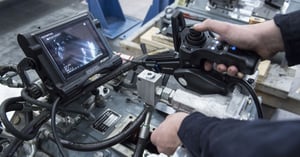Any operator knows the importance of maintenance. Of course, quality maintenance is important, but that relies on more than just maintaining the levels of lubricants and cooling fluids. To achieve the most stable uptime for your vessel or fleet there is one aspect that can be overlooked, and that is the importance of communication.
In this article we will explore typical maintenance needs, the value of good communication in an operation and how you can keep both downtime and extensive overhauls to a minimum.
Communication is key
Most vessels have at least one yearly scheduled maintenance, and an extensive class inspection every 5 years. For scheduled maintenance, the vessel is often lifted up on land, where the hull can be cleaned. You now have the opportunity do more extensive repairs at the same time. This is also the best opportunity to check play, wear and tear on propellers and rudder. This to foresee when any repair will be needed.
However, there are many tests, like of pressures and temperatures during operation which can’t be conducted with the ship in dry dock. Maintenance should therefore be considered a continuous process. It may be counter intuitive, but continuously monitoring and maintaining your ships performance is an important step of reducing its maintenance needs. This means knowing what to tend to and look for, which your manufacturer can advise on.
The goal will always be to keep more invasive overhauls to a minimum, and that requires continuous upkeep of the vessel and good communication between service personnel and the vessels crew. The supplier of key systems, like propulsion, should be familiar with the vessel’s operation. If they know the strain put on the vessel and its docked maintenance schedule, they can provide both expertise and components on-site when the vessel is raised.
Check with your supplier what can be done by your own crew. This involves key maintenance and monitoring done on a daily, weekly, and monthly basis:
- Lubrication
- Temperature monitoring
- Pressure monitoring
- Cleanliness (easier to see where potential leaks are coming from)
- Checking earth/ground
- Changes in operation, noises, vibrations etc.
Did it always do that?
Nobody knows a ship as its captain and crew, an old saying goes. If the crew also receive training in what to regularly tend to and look for, their insight is enhanced even further. Good communication between the supplier of key systems and the operator is a key aspect of maintenance that is often overlooked.
Both crew and service personnel should be aware of any recent changes in the ship’s behaviour. Higher temps, lower pressures etc., can be a solid indication what is required for the next overhaul. If this is not considered before a more comprehensive inspection takes place, you may look at lead times of weeks to months, depending on the issue and parts required.
Read more: How To Reduce The Operational Cost Of Your High-Speed Vessel
An apple a day..
A pre-emptive approach will always save you money, both in terms of repair costs and lost revenue from an asset out of service. Like people shouldn’t only go to the dentist or doctor when they are in pain, a ship should also receive regular check-ups and care.
On the ship’s crew side, good communication and training in the ships maintenance procedures and systems are vital. It can reduce the need for specialized service personnel from the supplier to be on-site at all.
Furthermore, when the supplier and crew know each other, basic tasks and procedures are easily communicated, extending the ships up-time through service done by the crew themselves. In case of an undetermined issue, the crew themselves can often conduct the troubleshooting procedures. This could be simple procedures, like swapping identical components from one side, checking if the problem moves with it. You will then have more time to plan repairs and assess required expertise and components. Asking one time to many is often better. Operating with a symptom or smaller defect may result in a big and expensive breakdown/downtime.
Established infrastructure and available components
Knowing ahead of time what a ship requires, and where, is a huge time and money saver. Some parts can take weeks or months to manufacture, especially for tailored solutions. Shipping of some components are also not a trivial affair. It can be a time consuming process and be heavy and require specialized transport. This is not something that should be left to the last moment.
Another important aspect is having qualified personnel and facilities available in the area of operation. Established suppliers have service partners across countries and regions. Here, technicians will have received certified and specialized training in proper maintenance and repairs of proprietary systems. They will also have an established supply chain and stock of parts. With these local resources, even extensive repairs can be completed in a most timely manner.
Read more: What Is Important When Selecting Propulsion Technology
I’ll do it myself
If you have a fleet large enough to warrant your own service infrastructure, you should still retain contact with the manufacturer. Thinking your own technicians will “just take care of it” can be detrimental to your operation. Nobody knows a ship’s system like the manufacturer themselves, who also hold pride and interest in their product being in good working order. They can provide training and guidance in terms of what needs to be done and when. They also know the history of the ships design and how its equipment performs under different operational profiles.
If the ship has a lighter operational profile, like a ferry in closed waters, major overhaul of the most complicated and expensive parts can be decades apart. It does not mean that your vessel does not need an overhaul before the 25 000-hour mark, but correct maintenance can save you some very unpleasant surprises.
Conclusion
You want a predictable and stable operation from your fleet or vessel. This requires regular maintenance and monitoring of the ships systems. But ‘regular’ does not mean ‘a lot’, especially when one considers the economic impact of larger overhauls and repairs in dry dock.
Good communication with your supplier and certified training of your own personnel can be both a cost and a literal lifesaver. Their recommendations can be valuable. A 3-hour check-up can save you 3 months of downtime due to overhauls and repairs. Letting your supplier know when and where they should have expertise and components ahead of time will reduce down time and maintenance cost.
Limiting your vessels need for major overhauls means, in short, that it receives continuous care, and its operation is closely monitored throughout. With the right training, this can be done by your own crew or service personnel. It requires no more than a few hours on a regular basis, without pulling the vessel out of operation. Failing to do so increases the risk of larger repairs and overhauls dramatically.
The top manufacturers have established service partners across regions and countries, which are resources that should not be underestimated. These cooperation’s are what provide the most timely and highest quality maintenance and repairs. However, this relies on them knowing your needs. For a smooth operation and keeping maintenance to a minimum, communication is therefore very important.



